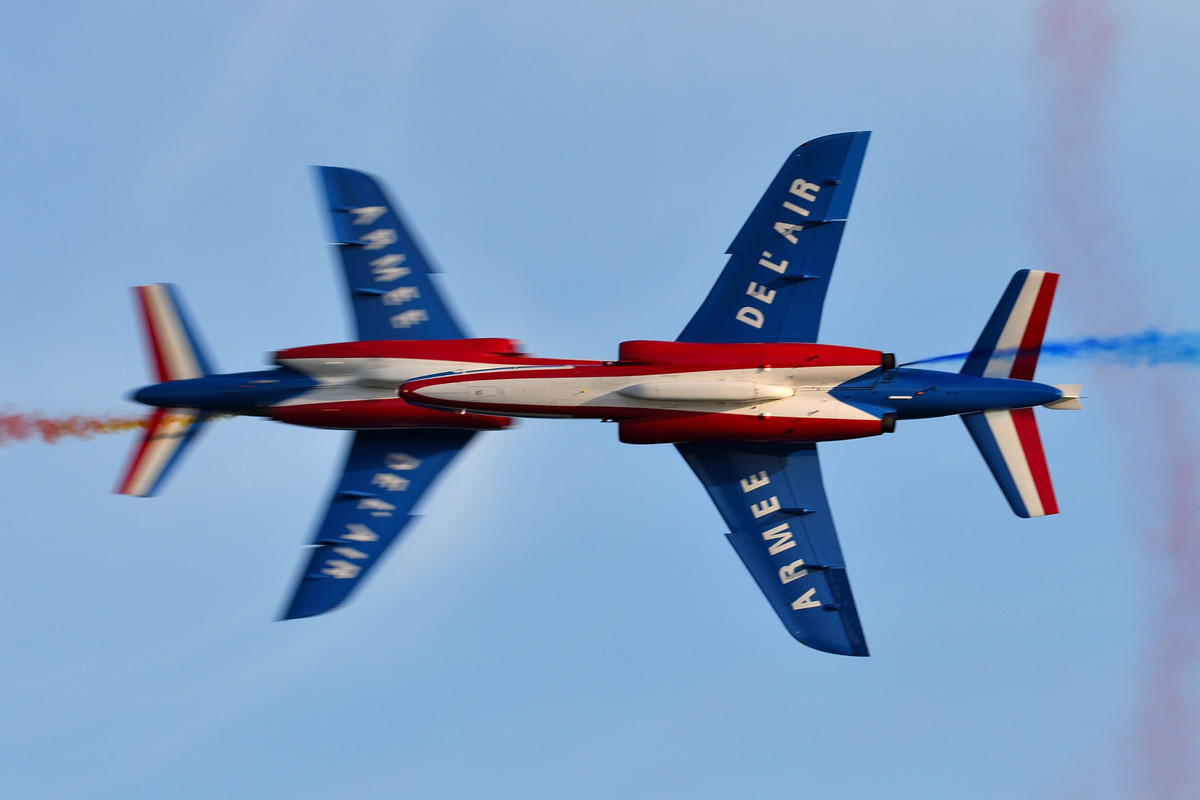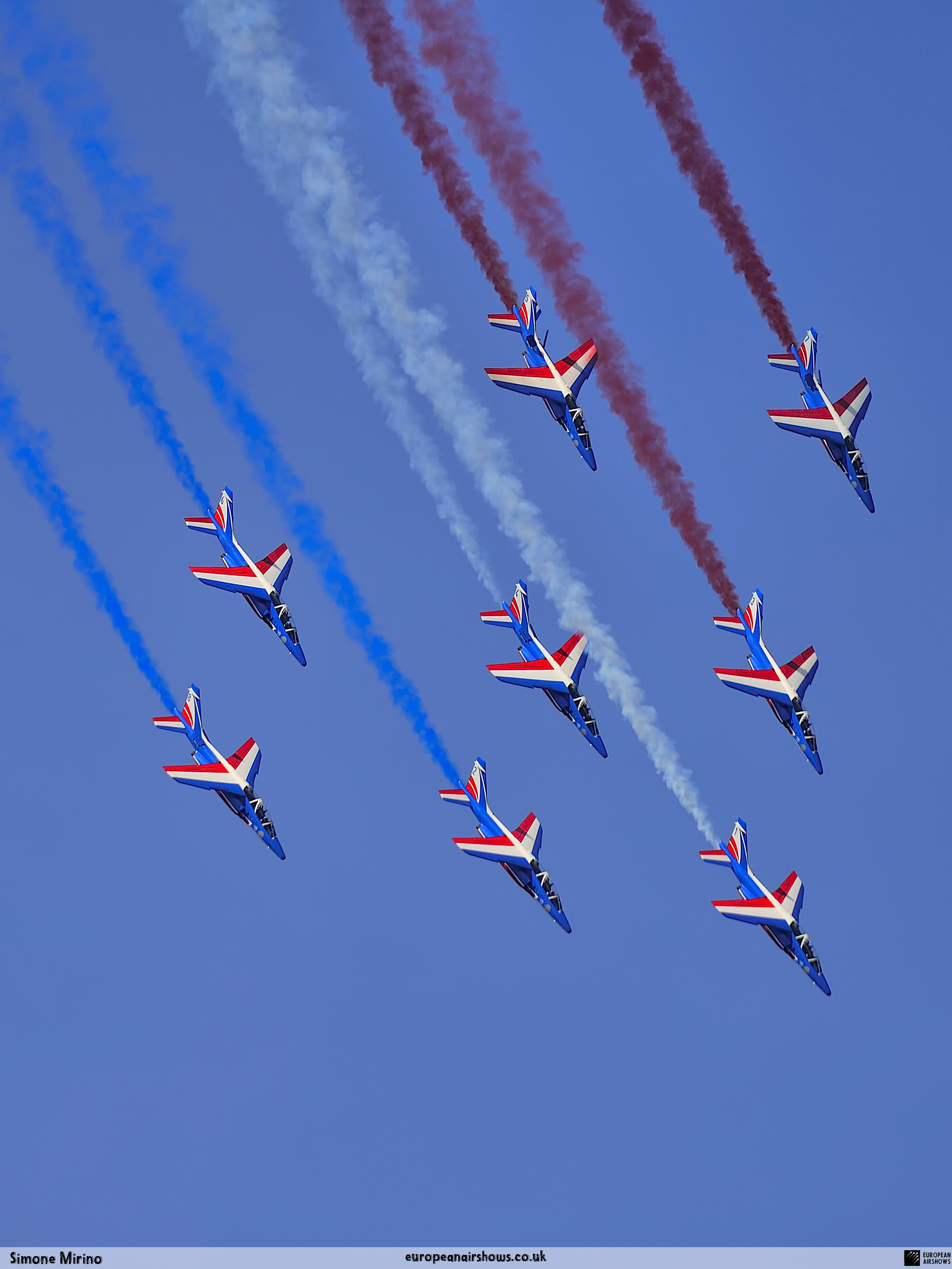
Patrouille de France
About the Team
The Patrouille Acrobatique de France, known affectionately as the Patrouille de France (PAF), is not just a precision aerobatics demonstration unit; it is a living testament to the artistry and engineering prowess of French aviation. Officially commissioned in 1953, the PAF operates under the auspices of the French Air and Space Force, proudly representing France on the global stage and fulfilling an ambassadorship role in the realm of aeronautics. Stationed at the scenic Aerial Base 701 in Salon-de-Provence, located in the picturesque Bouches-du-Rhône region, the PAF boasts a rich history that dates back to 1931, making it the oldest aerobatic team still active today.
Comprising a dedicated ensemble of nine highly skilled pilots and 35 meticulous mechanics, the Patrouille de France exemplifies the perfect blend of teamwork, discipline, and technical expertise. This elite unit meticulously balances its time between rigorous winter training sessions and exhilarating summer aerial displays, ensuring that each performance is nothing short of spectacular. The PAF’s mission extends beyond mere entertainment; it embodies the spirit of French aeronautics and showcases the nation’s commitment to excellence in aviation.
One of the most anticipated highlights of the PAF’s annual calendar is the Bastille Day military parade, where they traditionally open the festivities with a breathtaking aerial display over the heart of Paris. During this iconic event, nine Alpha Jets take to the sky, executing a meticulously choreographed twenty-minute demonstration filled with intricate formation changes and crossovers. The performance is narrated by the director of the French Air Force presentation team, who is also a seasoned jet pilot. This narration not only adds context to the maneuvers but also enhances the audience’s appreciation for the skill and precision involved. Safety is paramount in these high-stakes performances, with a dedicated photo and video specialist capturing each breathtaking maneuver while a pilot, often the replacement pilot, oversees communications between the PAF and air traffic control, ensuring that every flight is executed with the utmost safety and professionalism.
Team Overview
Number of Aircraft
8
Established
1953
Based
Salon-de-Provence Air Base
Aircraft Type
Dassault/Dornier Alpha Jet
About the aircraft
The Dassault/Dornier Alpha Jet is a light attack and advanced jet trainer aircraft developed in the 1970s through a collaboration between France’s Dassault Aviation and Germany’s Dornier Flugzeugwerke. It was designed to outperform earlier jet trainers and was selected for production after a competitive design process.
Primarily used by the French Air Force for training and the German Air Force for light attack roles, the Alpha Jet features a twin-engine configuration powered by SNECMA Turbomeca Larzac engines. It is known for its simple yet effective design, quick turnaround capabilities, and versatility in various roles, including aerial reconnaissance and electronic countermeasures.
Although the aircraft saw widespread use, particularly during the Cold War, budget cuts in the 1990s led to Germany retiring its fleet, with many Alpha Jets sold to other operators. The Alpha Jet remains in service with several air forces around the world and has demonstrated its effectiveness in both training and combat scenarios.
Team History
The storied history of the Patrouille de France is a thrilling narrative that begins in 1931 at Étampes-Mondésir Airport, where the first aerial demonstration was conducted by instructors from the Piloting Perfection School using Morane-Saulnier MS.230 aircraft. What started as a modest formation of three planes quickly gained traction and captivated audiences with its elegance and precision. Under the visionary leadership of Captain Pierre Fleurquin, the Patrouille d’Étampes flourished between 1932 and 1939, earning accolades for its impressive displays and establishing a reputation that would echo through the annals of aviation history. This early formation not only showcased remarkable flying skills but also positioned France as a notable participant in international aviation meetings, laying the groundwork for the legacy that would follow.
In 1935, the Patrouille d’Étampes underwent a significant transformation, upgrading to the MS.225 and expanding its fleet to five aircraft. This evolution demonstrated the unit’s growing capabilities and ambition. By 1937, the team had relocated to Salon-de-Provence and adopted the name Patrouille de l’École de l’Air. However, the onset of World War II brought a temporary halt to these aerial exploits, as the focus shifted to the pressing realities of war.
The post-war era ushered in a renewed spirit of aviation in France. In 1947, the Minister of Air established a representation squadron for the French Air Force, led by Captain Pierre, a former pilot of the Patrouille d’Étampes. Equipped with twelve Stampe SV-4 aircraft, this new unit quickly gained popularity, captivating audiences with its dynamic performances. The success of these presentations led to the formation of diverse aerial teams within the French Air Force, each contributing to the rich tapestry of French aviation.
By 1952, Commandant Pierre Delachenal, a pilot from the 3e Escadre stationed at Aerial Base 112 Reims-Champagne, formed an escadrille of four Republic F-84G aircraft. It was during an aerial meeting on May 17 in Algeria that the unit garnered an enthusiastic response from the crowd. The pilot show commentator and journalist Jacques Nœtinger, overwhelmed by the spectacle, officially christened the team as the Patrouille de France. This name was subsequently confirmed by the general staff headquarters of the French Air Force on September 14, 1953, marking a pivotal moment in the unit’s history.
The following decade was a period of growth and international acclaim for the Patrouille de France, with four Escadres of the French Air Force perpetuating the traditions of the team and contributing to its success on the world stage. However, in 1964, budgetary restrictions led to the dissolution of the Dassault Mystère IV patrol, casting uncertainty over the future of the iconic name. Yet, the Minister of the Armies was determined to preserve the legacy of the Patrouille de France, and a few months later, the designation was revived as the Patrouille de l’École de l’Air.
The introduction of the Fouga Magister aircraft marked a new chapter in the PAF’s history, with six of these planes becoming the torchbearers of French aerial aerobatics for an impressive sixteen years. The final presentation of the Fouga Magister, featuring nine aircraft, took place on September 16, 1980, at Salon-de-Provence, leaving behind a legacy of breathtaking performances and unforgettable moments.
In 1981, the PAF transitioned to the Dassault/Dornier Alpha Jet, which would become the backbone of the team. Initially starting with seven aircraft, the fleet expanded to eight by 1982, allowing for even more intricate and daring maneuvers. A landmark event occurred in 1986 when the PAF executed a historical display over the iconic skyline of New York City, solidifying its reputation as an international ambassador of aerial excellence.
The Patrouille de France continued to break barriers and set new standards in the world of aerobatics, culminating in a groundbreaking moment on November 25, 2009, when Commandant Virginie Guyot took command of the team. She became the first woman in history to lead an aerobatic team, a significant milestone that not only enriched the unit’s storied legacy but also inspired a new generation of aviators.
Today, the Patrouille de France stands as a beacon of excellence in aerobatics, captivating audiences worldwide with its breathtaking performances and showcasing the incredible skill and dedication of its pilots and mechanics. With each flight, the PAF continues to honor its rich history while embracing the future of aviation, ensuring that its legacy will soar for generations to come.
Did You Know?
- The Patrouille de France, established in 1953, is the precision aerobatics demonstration unit of the French Air and Space Force.
- This elite team is stationed at Aerial Base 701 in Salon-de-Provence and is known for its stunning aerial displays during major events, including the Bastille Day military parade.
- The team consists of 9 pilots and 35 mechanics, highlighting the collaborative effort behind each breathtaking performance.
- In a historic milestone, Commandant Virginie Guyot became the first female leader of the Patrouille de France in 2009, showcasing the unit’s commitment to diversity and inclusion.
- The Dassault/Dornier Alpha Jet has been the primary aircraft for the Patrouille de France since 1981, renowned for its agility and performance in aerobatic displays.
Test Your Knowledge
1. What year was the Patrouille de France officially commissioned?




































